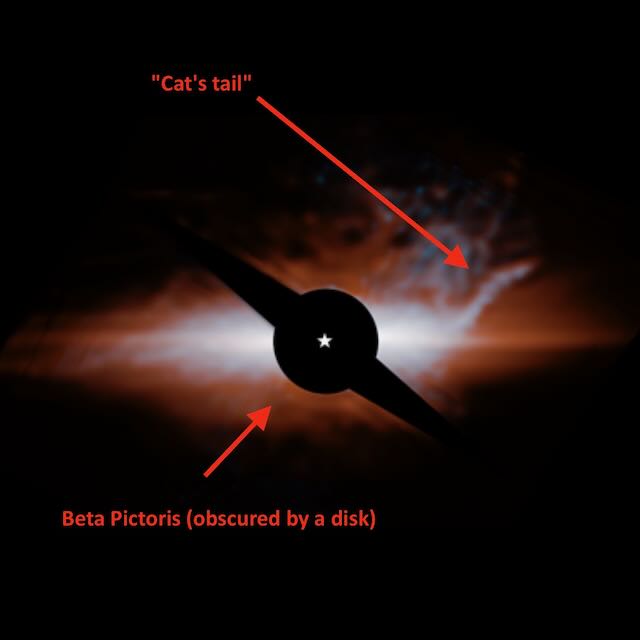
A cat’s tail in Beta Pictoris
Beta Pictoris is an astonishing nearby star system. In 1984, it became the very first star discovered to be surrounded by a bright disk of dust and debris. New planets are forming in this debris disk, and so the discovery confirmed astronomers’ theories on how planets form. And this beloved system continues to stun observers. On January 10, 2024, NASA said the enhanced power of the Webb space telescope has revealed an unusual and unexpected feature of the Beta Pictoris debris disk: a trail of dust some a 10 billion miles long (16 billion km long) extending from the star and looking for all the world like the flicking tail of a cat.
The peer-reviewed Astronomical Journal accepted a paper on the new discovery for publication in its February 2024 issue.
Isabel Rebollido of the Astrobiology Center in Spain and the study’s lead author described why this enigmatic star system continues to enthrall astronomers:
Beta Pictoris is the debris disk that has it all: It has a really bright, close star that we can study very well, and a complex cirumstellar environment with a multicomponent disk, exocomets, and two imaged exoplanets.
Overall, the papers’ authors estimate the cat’s tail contains an amount of dust equivalent to a large main belt asteroid.
Recent collision likely source of cat’s tail
The scientists who discovered the feline feature of Beta Pictoris think it may be evidence of a cataclysmic collision of objects in the star’s highly active debris disk. Moreover, they think it happened relatively recently, within the last 100 years or so.
Marshall Perrin, a co-author of the study at the Space Telescope Science Institute in Baltimore, Maryland, describes how the dust trail may have formed:
Something happens – like a collision – and a lot of dust is produced. At first, the dust goes in the same orbital direction as its source, but then it also starts to spread out. The light from the star pushes the smallest, fluffiest dust particles away from the star faster, while the bigger grains do not move as much, creating a long tendril of dust.
The high speed of the particles in the tail led the researchers to believe it consists of lightweight organic refractory material. Organic refractory material is the dark, dusty stuff found on the surface of comets and asteroids orbiting the sun. Indeed, we recently got a good look at some of it when OSIRIS-REx brought a sample of asteroid Bennu back to Earth.

The cat’s tail is bright in infrared
Eyes are the part of a cat one thinks of as glowing, but this cosmic cat’s tail shines too, yet only in the infrared spectrum. Astronomers used Webb’s Near-Infrared Camera (NIRCam) and Mid-Infrared Instrument (MIRI) to make the discovery. The researchers were investigating the composition of Beta Pictoris’s previously detected main and secondary debris disks.
Christopher Stark, a co-author of the study at NASA’s Goddard Space Flight Center, said the team was surprised by what they found:
We didn’t expect Webb to reveal that there are two different types of material around Beta Pictoris, but MIRI clearly showed us that the material of the secondary disk and cat’s tail is hotter than the main disk. The dust that forms that disk and tail must be very dark, so we don’t easily see it at visible wavelengths. But in the mid-infrared, it’s glowing.
Beta Pictoris is an active, busy and chaotic system
In addition, the recent investigation into Beta Pictoris also showed the star’s secondary debris disk is elongated in the opposite direction from the cat’s tail feature. Dust in the tail and the secondary disk share a temperature different from that in the star’s main debris disk. Consequently, this insight led the researchers to speculate a single collision may be responsible for both features.
Beta Pictoris, they said, has a lot going on:
Our research suggests that Beta Pictoris may be even more active and chaotic than we had previously thought. Webb continues to surprise us, even when looking at the most well-studied objects. We have a completely new window into these planetary systems.
See Beta Pictoris for yourself tonight
If you live far enough south on Earth’s globe, you can easily spot the star Beta Pictoris (though not its disk) with the unaided eye. From its distance of 63 light-years away, this star shines at magnitude 3.85, meaning it’s within the range of vision to the eye alone, in a dark sky. It lies in the direction of our constellation Pictor, the painter’s easel, which is visible in the sky now to those in the southern U.S. and similar latitudes. And it’s easy to find! It lies to the northwest of Canopus, another beloved star, and the 2nd-brightest star in Earth’s night sky.
And, while you gaze at its distant light, you can reflect on how Beta Pictoris has refined our understanding of star systems. The exoplanets astronomers have detected in the star’s orbit (Beta Pic b and c) are among the only ones we’ve imaged directly from Earth. We even have a movie of it circling its star.
Additionally, Beta Pictoris was also the first star to confirm other systems harbor comets. And we’ve found at least 30 so far!

Bottom line: Astronomers using the Webb space telescope discovered a cat’s tail of dust extending from the nearby star Beta Pictoris.
Via NASA’s Webb Space Telescope
Read more:
Exoplanet’s day lasts only 8 hours
Wow! Amazing timelapse of Beta Pictoris b
Astronomers capture 1st direct image of young giant exoplanet











